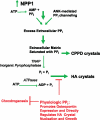Physiologic and pathologic functions of the NPP nucleotide pyrophosphatase/phosphodiesterase family focusing on NPP1 in calcification
- PMID: 18404477
- PMCID: PMC2254483
- DOI: 10.1007/s11302-005-5304-3
Physiologic and pathologic functions of the NPP nucleotide pyrophosphatase/phosphodiesterase family focusing on NPP1 in calcification
Abstract
The catabolism of ATP and other nucleotides participates partly in the important function of nucleotide salvage by activated cells and also in removal or de novo generation of compounds including ATP, ADP, and adenosine that stimulate purinergic signaling. Seven nucleotide pyrophosphatase/phosphodiesterase NPP family members have been identified to date. These isoenzymes, related by up conservation of catalytic domains and certain other modular domains, exert generally non-redundant functions via distinctions in substrates and/or cellular localization. But they share the capacity to hydrolyze phosphodiester or pyrophosphate bonds, though generally acting on distinct substrates that include nucleoside triphosphates, lysophospholipids and choline phosphate esters. PP(i) generation from nucleoside triphosphates, catalyzed by NPP1 in tissues including cartilage, bone, and artery media smooth muscle cells, supports normal tissue extracellular PP(i) levels. Balance in PP(i) generation relative to PP(i) degradation by pyrophosphatases holds extracellular PP(i) levels in check. Moreover, physiologic levels of extracellular PP(i) suppress hydroxyapatite crystal growth, but concurrently providing a reservoir for generation of pro-mineralizing P(i). Extracellular PP(i) levels must be supported by cells in mineralization-competent tissues to prevent pathologic calcification. This support mechanism becomes dysregulated in aging cartilage, where extracellular PP(i) excess, mediated in part by upregulated NPP1 expression stimulates calcification. PP(i) generated by NPP1modulates not only hydroxyapatite crystal growth but also chondrogenesis and expression of the mineralization regulator osteopontin. This review pays particular attention to the role of NPP1-catalyzed PP(i) generation in the pathogenesis of certain disorders associated with pathologic calcification.
Figures


Similar articles
-
Chondrogenesis mediated by PPi depletion promotes spontaneous aortic calcification in NPP1-/- mice.Arterioscler Thromb Vasc Biol. 2005 Apr;25(4):686-91. doi: 10.1161/01.ATV.0000154774.71187.f0. Epub 2004 Dec 29. Arterioscler Thromb Vasc Biol. 2005. PMID: 15625282
-
Linked deficiencies in extracellular PP(i) and osteopontin mediate pathologic calcification associated with defective PC-1 and ANK expression.J Bone Miner Res. 2003 Jun;18(6):994-1004. doi: 10.1359/jbmr.2003.18.6.994. J Bone Miner Res. 2003. PMID: 12817751
-
Inorganic pyrophosphate (PPI) in pathologic calcification of articular cartilage.Front Biosci. 2005 Jan 1;10:988-97. doi: 10.2741/1593. Print 2005 Jan 1. Front Biosci. 2005. PMID: 15569637 Review.
-
Subcellular targeting and function of osteoblast nucleotide pyrophosphatase phosphodiesterase 1.Am J Physiol Cell Physiol. 2004 May;286(5):C1177-87. doi: 10.1152/ajpcell.00320.2003. Epub 2003 Dec 24. Am J Physiol Cell Physiol. 2004. PMID: 15075217
-
Nucleotide pyrophosphatase/phosphodiesterase 1 (NPP1) and its inhibitors.Medchemcomm. 2017 Feb 9;8(5):823-840. doi: 10.1039/c7md00015d. eCollection 2017 May 1. Medchemcomm. 2017. PMID: 30108800 Free PMC article. Review.
Cited by
-
The role of phosphatases in the initiation of skeletal mineralization.Calcif Tissue Int. 2013 Oct;93(4):299-306. doi: 10.1007/s00223-012-9672-8. Epub 2012 Nov 27. Calcif Tissue Int. 2013. PMID: 23183786 Free PMC article. Review.
-
Phospholipases of mineralization competent cells and matrix vesicles: roles in physiological and pathological mineralizations.Int J Mol Sci. 2013 Mar 1;14(3):5036-129. doi: 10.3390/ijms14035036. Int J Mol Sci. 2013. PMID: 23455471 Free PMC article.
-
2-MeS-beta,gamma-CCl2-ATP is a potent agent for reducing intraocular pressure.J Med Chem. 2010 Apr 22;53(8):3305-19. doi: 10.1021/jm100030u. J Med Chem. 2010. PMID: 20337495 Free PMC article.
-
Deficiency of the bone mineralization inhibitor NPP1 protects mice against obesity and diabetes.Dis Model Mech. 2014 Dec;7(12):1341-50. doi: 10.1242/dmm.017905. Epub 2014 Oct 31. Dis Model Mech. 2014. PMID: 25368121 Free PMC article.
-
Osteoblast-specific deficiency of ectonucleotide pyrophosphatase or phosphodiesterase-1 engenders insulin resistance in high-fat diet fed mice.J Cell Physiol. 2021 Jun;236(6):4614-4624. doi: 10.1002/jcp.30194. Epub 2020 Dec 10. J Cell Physiol. 2021. PMID: 33305372 Free PMC article.
References
-
- {'text': '', 'ref_index': 1, 'ids': [{'type': 'DOI', 'value': '10.1055/s-2005-869527', 'is_inner': False, 'url': 'https://doi.org/10.1055/s-2005-869527'}, {'type': 'PubMed', 'value': '15852225', 'is_inner': True, 'url': 'https://pubmed.ncbi.nlm.nih.gov/15852225/'}]}
- Robson SC, Wu Y, Sun X et al. Ectonucleotidases of CD39 family modulate vascular inflammation and thrombosis in transplantation. Semin Thromb Hemost 2005; 31: 217–33. - PubMed
-
- {'text': '', 'ref_index': 1, 'ids': [{'type': 'DOI', 'value': '10.1007/s11302-005-6314-x', 'is_inner': False, 'url': 'https://doi.org/10.1007/s11302-005-6314-x'}, {'type': 'PMC', 'value': 'PMC2096540', 'is_inner': False, 'url': 'https://pmc.ncbi.nlm.nih.gov/articles/PMC2096540/'}, {'type': 'PubMed', 'value': '18404510', 'is_inner': True, 'url': 'https://pubmed.ncbi.nlm.nih.gov/18404510/'}]}
- Vorhoff T, Zimmermann H, Pelletier J et al. Cloning and characterization of the ecto-nucleotidase NTPDase3 from rat brain: Predicted secondary structure and relation to other members of the E-NTPDase family and actin. Purinergic Signalling 2005; 1: 259–70. - PMC - PubMed
-
- {'text': '', 'ref_index': 1, 'ids': [{'type': 'PubMed', 'value': '8759717', 'is_inner': True, 'url': 'https://pubmed.ncbi.nlm.nih.gov/8759717/'}]}
- Deterre P, Gelman L, Gary-Gouy H et al. Coordinated regulation in human T cells of nucleotide-hydrolyzing ecto-enzymatic activities, including CD38 and PC-1. Possible role in the recycling of nicotinamide adenine dinucleotide metabolites. J Immunol 1996; 157: 1381–8. - PubMed
-
- {'text': '', 'ref_index': 1, 'ids': [{'type': 'DOI', 'value': '10.1016/j.tibs.2005.08.005', 'is_inner': False, 'url': 'https://doi.org/10.1016/j.tibs.2005.08.005'}, {'type': 'PubMed', 'value': '16125936', 'is_inner': True, 'url': 'https://pubmed.ncbi.nlm.nih.gov/16125936/'}]}
- Stefan C, Jansen S, Bollen M. NPP-type ectophosphodiesterases: Unity in diversity. Trends Biochem Sci 2005; 30: 542–50. - PubMed
-
- {'text': '', 'ref_index': 1, 'ids': [{'type': 'PMC', 'value': 'PMC60151', 'is_inner': False, 'url': 'https://pmc.ncbi.nlm.nih.gov/articles/PMC60151/'}, {'type': 'PubMed', 'value': '11598187', 'is_inner': True, 'url': 'https://pubmed.ncbi.nlm.nih.gov/11598187/'}]}
- Bello V, Goding JW, Greengrass V et al. Characterization of a di-leucine-based signal in the cytoplasmic tail of the nucleotide-pyrophosphatase NPP1 that mediates basolateral targeting but not endocytosis. Mol Biol Cell 2001; 12: 3004–15. - PMC - PubMed
Grants and funding
LinkOut - more resources
Full Text Sources
Other Literature Sources
Research Materials
Miscellaneous

